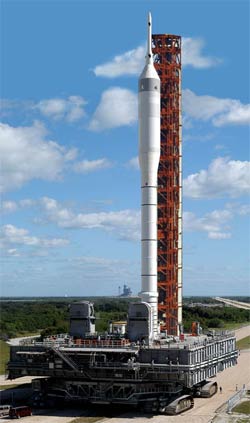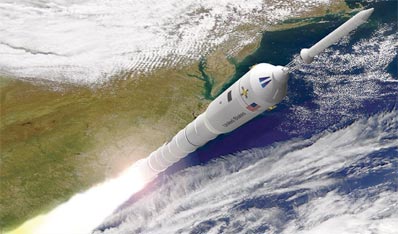
Spaceflight Now +

|

|

|

|

Premium video content for our Spaceflight Now Plus subscribers.

Mars rover panoramas
 New panoramas from NASA's long-lasting Mars Exploration Rovers show the view from the Columbia Hills where Spirit continues its adventure and the strange landscape at Meridiani Planum where Opportunity is driving southward. New panoramas from NASA's long-lasting Mars Exploration Rovers show the view from the Columbia Hills where Spirit continues its adventure and the strange landscape at Meridiani Planum where Opportunity is driving southward.

 Spirit | Opportunity Spirit | Opportunity

Hubble Space Telescope
 Scientists marvel at the achievements made by the orbiting Hubble Space Telescope in this produced movie looking at the crown jewel observatory that has served as our window on the universe. Scientists marvel at the achievements made by the orbiting Hubble Space Telescope in this produced movie looking at the crown jewel observatory that has served as our window on the universe.

 Play video Play video

SOHO anniversary
 10 years ago: The Solar and Heliospheric Observatory, a joint European and American Sun-watching probe, blasts off from Cape Canaveral aboard a Lockheed Martin Atlas 2AS rocket. 10 years ago: The Solar and Heliospheric Observatory, a joint European and American Sun-watching probe, blasts off from Cape Canaveral aboard a Lockheed Martin Atlas 2AS rocket.

 Play video Play video

Huygens science results
 The European Space Agency's Huygens probe, launched from NASA's Cassini spacecraft, descended through the atmosphere of Saturn's moon Titan and landed on its mysterious surface in January. Scientists hold this news briefing to report on new results from the daring mission. The European Space Agency's Huygens probe, launched from NASA's Cassini spacecraft, descended through the atmosphere of Saturn's moon Titan and landed on its mysterious surface in January. Scientists hold this news briefing to report on new results from the daring mission.

 Play video Play video

Mars Express update
 Project scientists working on the European Space Agency's Mars Express spacecraft now orbiting the Red Planet hold a news conference to announce some interesting results from the ongoing mission. Project scientists working on the European Space Agency's Mars Express spacecraft now orbiting the Red Planet hold a news conference to announce some interesting results from the ongoing mission.

 Play video Play video

An American in orbit
 Mercury astronaut John Glenn becomes the first American to orbit the Earth on February 20, 1962, when he is launched aboard Friendship 7. Mercury astronaut John Glenn becomes the first American to orbit the Earth on February 20, 1962, when he is launched aboard Friendship 7.

 Play video Play video

Space Thanksgiving
 International Space Station commander Bill McArthur and flight engineer Valery Tokarev mark the Thanksgiving holiday in orbit during this downlinked message. International Space Station commander Bill McArthur and flight engineer Valery Tokarev mark the Thanksgiving holiday in orbit during this downlinked message.

 Play video Play video

Soyuz on the move
 Expedition 12 Soyuz commander Valery Tokarev and station commander Bill McArthur temporarily leave the International Space Station. They undocked their Soyuz capsule from the Pirs module and then redocked the craft to the nearby Zarya module. The move clears Pirs for use as the airlock for an upcoming Russian-based spacewalk. Expedition 12 Soyuz commander Valery Tokarev and station commander Bill McArthur temporarily leave the International Space Station. They undocked their Soyuz capsule from the Pirs module and then redocked the craft to the nearby Zarya module. The move clears Pirs for use as the airlock for an upcoming Russian-based spacewalk.

 Play video Play video

Pluto New Horizons
 Check out NASA's Pluto-bound New Horizons spacecraft undergoing thermal blanket installation inside the cleanroom at Kennedy Space Center's Payload Hazardous Servicing Facility in preparation for launch in January from the Cape. Check out NASA's Pluto-bound New Horizons spacecraft undergoing thermal blanket installation inside the cleanroom at Kennedy Space Center's Payload Hazardous Servicing Facility in preparation for launch in January from the Cape.

 Play video Play video

Mountains of creation
 A new image from NASA's Spitzer Space Telescope reveals billowing mountains of dust ablaze with the fires of stellar youth. The majestic infrared view from Spitzer resembles the iconic "Pillars of Creation" picture taken of the Eagle Nebula in visible light by NASA's Hubble Space Telescope. A new image from NASA's Spitzer Space Telescope reveals billowing mountains of dust ablaze with the fires of stellar youth. The majestic infrared view from Spitzer resembles the iconic "Pillars of Creation" picture taken of the Eagle Nebula in visible light by NASA's Hubble Space Telescope.

 Play video Play video

 Become a subscriber Become a subscriber
 More video More video

|

|

|

|
|

|

Former shuttle chief talks about new CEV launcher
BY WILLIAM HARWOOD
STORY WRITTEN FOR CBS NEWS "SPACE PLACE" & USED WITH PERMISSION
Posted: December 8, 2005
As expected, shuttle solid-fuel rocket builder Alliant Techsystems - ATK - will be the prime contractor for design and development of the first stage of NASA's next-generation Crew Launch Vehicle, intended to propel astronauts into low-Earth orbit after the space shuttle's retirement in 2010.
| |

An illustration shows the Crew Launch Vehicle design using a shuttle solid rocket booster. Credit: ATK/NASA
|
Ron Dittemore, president of ATK Thiokol Propulsion of Brigham City, Utah,
and a former space shuttle program manager for NASA, told CBS News Wednesday
details of the eventual contract are still being worked out, including what
sort of test flights might be required. But he said the company could be
ready for an unmanned test launch, using a modified "single-stick" shuttle
booster and a dummy upper stage, before the end of 2008.
NASA's new space exploration architecture calls for completing the
international space station by 2010 and replacing the space shuttle with a
new Crew Exploration Vehicle, or CEV, reminiscent of the Apollo moon
capsules of the 1960s and 1970s. NASA plans to retire the shuttle by 2010
and to launch the first CEV in the 2011/2012 time frame.
The CEV will be boosted into space by a two-stage launch vehicle made up
of a modified shuttle solid-fuel rocket booster, built by ATK, and a liquid
oxygen/liquid hydrogen fueled upper stage. The CEV will be equipped with
solid-fuel escape rockets like NASA's Apollo and Mercury capsules.
"What we have so far is NASA has announced (Wednesday) their intention to
have ATK be the prime for the first stage of the Crew Launch Vehicle,"
Dittemore said in a telephone interview. "And as that continues to work
forward, NASA and ATK will work together to define the scope of the
activities over the next several months and turn that scope into actual
milestones and performance agreements between the two of us."
The CLV first stage as currently envisioned would be made up of a
standard four-segment space shuttle rocket booster with an interstage
adapter to interface with the upper stage. The nozzle, steering system and
other components in the aft end of the booster would be virtually unchanged,
allowing NASA to launch it from the same mobile launch platforms currently
used by space shuttles.

This artist's concept shows the Crew Exploration Vehicle launching to space atop the shuttle SRB-derived booster. Credit: ATK
|
Details about what - if any - test flights might be required are still
being discussed. But "you could do a test flight of the first stage, a dummy
second stage and maybe some type of capsule or launch abort system on top"
without any major modifications of existing infrastructure at the Kennedy
Space Center, Dittemore said.
"The mobile launch platform, you know it's got two holes today for the
solid rocket motors," he said. "You might cover one hole up and you'd still
use the same attach hardware, the hold-down posts. And so there's probably
very little that you would have to do for a test flight."
When could such a flight be launched?
"I think it's perfectly reasonable to say that we could do a test flight
before 2008 is complete," Dittemore said. "A first stage, the interstage
required to mate to a second stage, you could have a mass simulator for a
second stage and still do a number of different technical objectives if NASA
so desired. But you could do that type of test before 2008 is complete.
"And of course, you would like to have your first full-up test flight
near the end of the decade to support the retirement of the shuttle. In
2010, 2011, you'd like to be ready with the full vehicle."
Dittemore called Wednesday's announcement "the first step in moving
toward cutting metal and getting hardware ready for the real fire and smoke
activities that need to take place for us to get ready to replace the
shuttle."

Additional coverage for subscribers:
 VIDEO:
LUNAR ARCHITECTURE PLAN DIAL-UP | BROADBAND VIDEO:
LUNAR ARCHITECTURE PLAN DIAL-UP | BROADBAND
 VIDEO:
QUESTION AND ANSWER SESSION DIAL-UP | BROADBAND VIDEO:
QUESTION AND ANSWER SESSION DIAL-UP | BROADBAND
 VIDEO:
NARRATED ANIMATION OF NEW ROCKETS PLAY | Free preview VIDEO:
NARRATED ANIMATION OF NEW ROCKETS PLAY | Free preview
 VIDEO:
NARRATED ANIMATION OF LUNAR LANDER PLAY | Free preview VIDEO:
NARRATED ANIMATION OF LUNAR LANDER PLAY | Free preview
 SUBSCRIBE NOW SUBSCRIBE NOW

|

|

|

|


|



